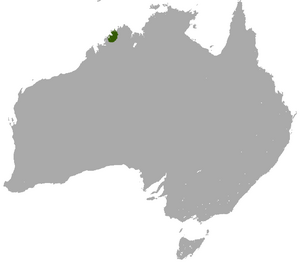Monjon facts for kids
Quick facts for kids Monjon |
|
|---|---|
| Conservation status | |
| Scientific classification | |
 |
|
| Monjon range |
The monjon is a small and shy type of rock-wallaby. It is the smallest of all rock-wallabies! These amazing animals live in the Kimberley region of north-west Australia. You can also find them on some nearby islands in the Bonaparte Archipelago.
Contents
Discovering the Monjon
The monjon is a macropod, which is a group of animals that includes kangaroos and wallabies. Scientists first officially described the monjon in 1978. Two scientists, D. J. Kitchener and G. Sanson, found and studied these animals.
The first monjon they described was a female. She weighed about 1.4 kilograms (around 3 pounds). Kitchener found her in a sandstone crack in November 1976. This was near Crystal Creek on the Mitchell Plateau. She even had a tiny, furless baby in her pouch!
Scientists also found monjons on islands like Boongaree, Katers, and Bigge Island. These islands are part of the Bonaparte Archipelago. They also found them in the Prince Regent National Park.
How the Monjon Got Its Name
The monjon's scientific name, Petrogale burbidgei, honors Andrew A. Burbidge. He was a scientist who encouraged surveys of mammals in the Kimberley region.
At first, the monjon was called 'warabi'. This was thought to be its name in the local Wunumbal language. However, later on, people realized that 'warabi' actually meant something else. After talking more with local Indigenous communities, several names for the animal were found. The name 'monjon' was then suggested and accepted. It replaced the earlier name. People also sometimes call it the Burbidge's rock-wallaby or Burbidge's rock-weasel.
What Does a Monjon Look Like?
The monjon is the smallest rock-wallaby. Its head and body together are about 30 to 35 centimeters long. That's about the length of a school ruler! They weigh between 950 grams and 1.4 kilograms. This is about the same weight as a small bag of sugar.
Their tail is quite long, from 26.5 to 39 centimeters. It's a brownish-yellow color with dark spots. The end of the tail has a tuft of dark brown hair. Their ears are very short, only about 3 to 3.3 centimeters long. They also have large, black eyes.
The fur on their back is an olive-buff color, which looks like a deep, marbled green-brown. The front of their head is a reddish-brown, becoming lighter on their cheeks. Their belly and chin are pale or whitish, sometimes with a yellowish tint.
Monjons are quite shy animals. They are mostly active at night. They can move very quickly and skillfully among the rocks.
Where Monjons Live
Monjons live in areas that get a lot of rain. They are found along the coast and on islands in the Kimberley region. These places get about 1,200 to 1,400 millimeters of rain each year.
They are common in the few places where they are known to live. This includes Bigge, Boongaree, and Katers islands. Monjons like to live among King Leopold sandstone formations. The plants around them are usually open woodlands with eucalypt trees and Owenia vernicosa plants.
You can also find monjons in the Charnley River–Artesian Range Wildlife Sanctuary. This sanctuary is also in the Kimberley region of Western Australia.
Monjon Life and Habits
Monjons like to hide in caves or cracks in the sandstone rocks. Their main food is grasses and ferns.
Scientists believe that monjons can have babies all year round. However, most births happen during the northern wet season.
The monjon is currently listed as near threatened. This means they could become endangered in the future. One reason for this is that they live in a very small area.
See also
 In Spanish: Monjon para niños
In Spanish: Monjon para niños


